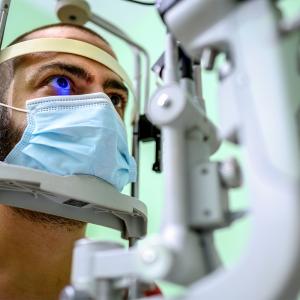Brain Injuries May Cause Astrocytes to Kill the Very Nerves They Normally Nourish

Photo: JUAN GAERTNER/SCIENCE PHOTO LIBRARY/Getty
After a brain injury, cells that normally nourish nerves may actually kill them instead, a new study in rodents finds. This “reactive” phenomenon may be the driving factor behind neurodegenerative diseases like glaucoma, a leading cause of blindness.
Led by researchers at NYU Grossman School of Medicine, the study examined what happens when pressure builds up in the eye and damages the nerve cells that connect the eyes and brain. Although experts have long linked this condition to glaucoma, it remained unclear how excess pressure leads to cell death.
The new investigation revealed that increased pressure drove astrocytes—a star-shaped glial cell of the central nervous system—to release as-yet-unidentified neuron-killing toxins, possibly to “clear away” damaged cells. Meanwhile, excess pressure had little effect on nerves when astrocytes were not present. In addition, when astrocytes were prevented from reacting to pressure, neurons were damaged, but not as badly.
“Our findings point to astrocytes as the true culprits behind nerve cell death and highlight a new way of treating a neurodegenerative disease like glaucoma,” says study senior author Shane A. Liddelow, PhD, an assistant professor in the Department of Neuroscience and Physiology at NYU Langone Health. “Perhaps targeting astrocytes after an injury may be the way to keep neurons healthy and help prevent further deterioration.”
Dr. Liddelow, also an assistant professor in NYU Langone’s Department of Ophthalmology, adds that while half of all brain cells are astrocytes, most research on glaucoma has historically focused on neurons, the electrically active cells that send messages throughout nerve tissue.
The study findings, he says, make clear that in order to understand neurodegenerative diseases, experts must look beyond neurons to the cells that surround them, including astrocytes, which are named after the Greek word for star.
His previous research in rodents showed that astrocytes could become reactive immediately after nerves are physically damaged. The new investigation, published online June 23 in the journal Cell Reports, is believed to be the first to show that reactive astrocytes kill cells over time in a process similar to what occurs in glaucoma, the study authors say.
In addition, the findings may help explain why brain cells continue to die long after excess pressure has been controlled. According to Dr. Liddelow, dying neurons spill inflammatory compounds into the surrounding tissue, which may further aggravate astrocytes and lead to a continuous cycle of cell destruction.
For their investigation, the study authors increased eye pressure for two weeks in several dozen rats and mice, some of which had been genetically engineered to lack these neuron-killing reactive astrocytes.
They found that while the unmodified mice lost up to half of the neurons in the injured area, those without toxic astrocytes saw little cell death. In addition, neurons that survived continued to send electrical signals.
To examine whether neurons survive if astrocytes are prevented from releasing toxins, the researchers increased pressure again, this time disrupting inflammation in some of the animals to prevent their astrocytes from becoming reactive.
Although the findings suggest that blocking astrocytes is a potential means of preventing nerve damage in people with glaucoma, he cautions that researchers do not yet know whether the resulting effects are permanent or what side effects may occur.
Next, the research team plans to investigate whether this treatment can actually improve vision in animals with glaucoma, as well as to study astrocyte behavior in related conditions like Alzheimer’s disease, Parkinson’s disease, and Lou Gehrig’s disease.
Funding for the study was provided by the National Institutes of Health grants R01 EY026100, R01 EY027713, and P30 EY026877. Additional support was provided by the Cure Alzheimer’s Foundation and the Glenn Foundation Glenn Award. Dr. Liddelow maintains a financial interest in AstronauTx Ltd, a company targeting astrocytes as a possible treatment target for Alzheimer’s disease. The terms and conditions are being managed in accordance with the policies of NYU Langone.
In addition to Dr. Liddelow, other NYU Langone investigators involved in the study are Rana El-Danaf, PhD; Indigo Rose, MS; and Medical Scientist Training Program student Drew Adler. Additional research support was provided by Alexandra Münch, BA; Maya Weigel, BA; and Andrew Huberman, PhD, at Stanford University in California. Kevin Guttenplan, PhD, also at Stanford University, is the study lead investigator.
Media Inquiries
Shira Polan
Phone: 212-404-4279
shira.polan@nyulangone.org
